Definitions for Pest Control Categories 7 and 8
Category 7 - All applicators using pesticides in, on, or around food handling establishments, human dwellings, institutions such as schools and hospitals, and industrial establishments. This certification covers the use of pesticides in the control of general pests and wood-destroying organisms by all means other than fumigation, and covers all elements of "wood-destroying organism" certification.
Category 8 - State, federal or other governmental employees using pesticides in public health programs for the management and control of pests having medical and public health importance.
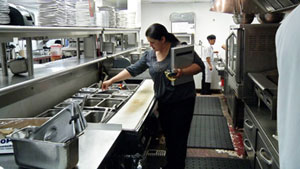
Food handling area (www.denver.gov)
A food handling establishment is an area or place, other than a private residence, where food is held, prepared, and /or served.
Food areas of food handling establishments include areas for receiving serving, storage (dry, wet, sold, frozen, raw) packaging, edible waste storage, and enclosed processing systems.
Non-food areas of food handling establishments include garage rooms, restrooms, floor drains to sewers, entries and vestibules, locker rooms, boiler rooms, garages, mop closets, and storage (after canning or boiling).
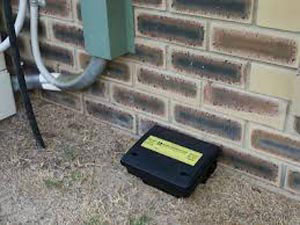
Rodent bait stations in areas accessible to children
or pets must be tamper-proof (pestcontroladvice.net)
Bait formulation is a pesticide active ingredient mixed with food or another attractive substance. Insecticide baits are used in and around buildings to control pests such as ants, cockroaches, and flies. Baits are often used to control vertebrate pests such as rodents and birds. They work best when sanitation is good so there are few other food sources to compete with them. Often small amounts are placed in many locations because the target pests move in and out of an area.
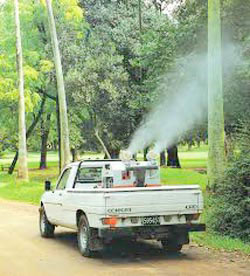
Cold fogger (www.rollbackmalaria.com)
Cold foggers use small motors to produce a high power, low pressure air stream with small droplets of insecticide.
- Advantages: No fog to cause traffic hazard. Little or no smell. Lower noise level. Some ready to use formulations, no mixing is required.
- Disadvantages: Longer application time. Fog barely visible so it is difficult to see where the treatment is going. Higher technical skill of applicator needed and regular calibration required.
Contact treatment is the application of a wet spray to kill insects immediately.
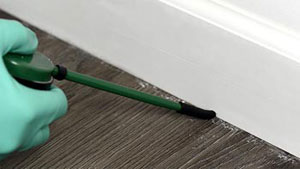
Crack and crevice treatments target hiding places and entryways.
(www.bedbugsupply.com)
Crack and crevice treatments are applications of small amounts of insecticides into cracks and crevices where pests may hide or may move in and out of rooms or enter buildings. Dust formulations are often used in these cases. Dusts may quickly lose their effectiveness in humid or wet areas. Do not use them around people with respiratory problems.
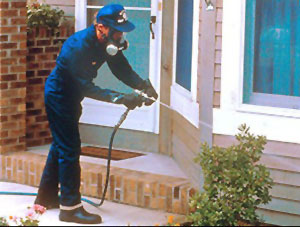
General treatments are applied over large areas. (www.tn.gov)
General treatments are applied over broad areas, such as walls, floors, or ceilings, or outdoors.
Non-residual insecticides are those applied to kill insects only during the time of treatment and are applied either as space treatments or contact treatments.
Residual insecticides are products that are applied to kill insects over several hours or longer and are applied as general, spot, or crack and crevice treatments.
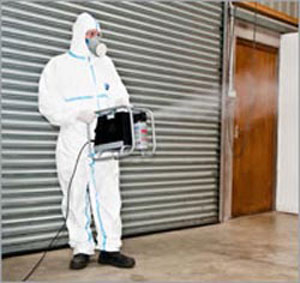
Applicators must wear the proper safety equipment
when making a space treatment (www.northernpo.co.uk)
Space treatment is the dispersal of insecticides into the air by foggers, misters, aerosol devices, or vapor dispensers to control flying insects and exposed crawling insects. Labels often require that fans and pilot lights be turned off.
Spot treatments are applied to limited areas where pest s are likely to occur but that will not be in contact with food or utensils and will not ordinarily be contacted by workers.
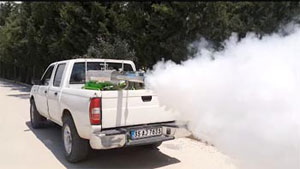
Thermal fogger (www.solutionsstores.com)
Thermal foggers, as the name suggests, use heat in the fogging process. Thermal foggers use heat to vaporize a fogging solution and spray it out in form of a fog. Thermal foggers are equipped with a heat barrel that gets preheated to high temperatures using either a propane gas or electricity depending on the type of a fogger. The fogging solution is in a liquid form, and when it gets pumped into the heat barrel, it instantly is vaporized. This allows the fogger to produce large count of particles in extremely small size, which all together forms a dense cloud of fog.
- Advantages: High flow rate allows shorter application time. The dense visible fog is visible so you can see where the application is going. Better dispersion and higher density spray droplets increases chance of hitting flying insects.
- Disadvantages: Higher cost of diluent. Strong smell and possible staining. Dense fog is a traffic hazard. Noisy equipment. Smaller particles can drift off target and are easier to disrupt with winds.
Ultra Low Volume is the application of an insecticide as small particles (0.1 to 50 microns in diameter) in a volume of 0.5 gal or less per acre. For the control of public health vectors and pests, insecticide formulations are dispersed in concentrations of 10-90% active ingredients at flow rates up to 18 fluid ounces per minute. The insecticide must be delivered within certain droplet size parameters to be effective. The optimum droplet size for effective (=90% mortality) mosquito control by space spraying via ground application equipment is 8-15 microns. For comparison, the diameter of a human hair is about 30 microns.
[return]








